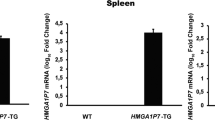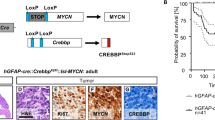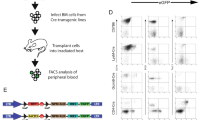Abstract
In recent years, there has been mounting evidence pointing to the association of polyomaviruses with a wide range of human cancers. The human neurotropic polyomavirus, JCV, infecting greater than 75% of the human population produces a regulatory protein named T-antigen which is expressed at the early phase of viral lytic infection and plays a critical role in completion of the viral life cycle. Furthermore, this protein has the ability to transform neural cells in vitro and its expression has been detected in several human neural-origin tumors. To further investigate the oncogenic potential of the JCV early protein in vivo, transgenic mice expressing JCV T-antigen under the control of its own promoter were generated. Nearly 50% of the animals developed large, solid masses within the base of the skull by 1 year of age. Evaluation of the location as well as histological and immunohistochemical data suggest that the tumors arise from the pituitary gland. As T-antigen is known to interact with several cell cycle regulators, the neoplasms were analysed for the presence of the tumor suppressor protein, p53. Immunoprecipitation/Western blot analysis demonstrated overexpression of wild-type, but not mutant p53 within tumor tissue. In addition, co-immunoprecipitation established an interaction between p53 and T-antigen and overexpression of p53 downstream target protein, p21/WAF1. This report describes the analysis of inheritable pituitary adenomas induced by expression of the human polyomavirus, JCV T-antigen in transgenic mice where T-antigen disrupts the p53 pathway by binding to and sequestering wild-type p53. This animal model may serve as a useful tool to further evaluate mechanisms of tumorigenesis by JCV T-antigen.
This is a preview of subscription content, access via your institution
Access options
Subscribe to this journal
Receive 50 print issues and online access
$259.00 per year
only $5.18 per issue
Buy this article
- Purchase on Springer Link
- Instant access to full article PDF
Prices may be subject to local taxes which are calculated during checkout





Similar content being viewed by others
References
Arbeit JM, Munger K, Howley PM and Hanahan D. . 1993 Am. J. Pathol. 142: 1187–1197.
Blagosklonny MV. . 1997 Oncogene 15: 1889–1893.
Buckley N, Bates AS, Broome JC, Strange RC, Perret CW, Burke CW and Clayton RN. . 1994 J. Clin. Endocrinol. Metab. 79: 1513–1516.
Franks RR, Rencic A, Gordon J, Zoltick PW, Curtis M, Knobler RL and Khalili K. . 1996 Oncogene 12: 2573–2578.
Frisque RJ and White FA. . (1992). Molecular Neuroviology. Roos RP. (ed.). Totowa, NJ: Humana Press pp. 25–158.
Gallia GL, Gordon J and Khalili K. . 1998 J. Neurovirol. 4: 175–181.
Gartel AL and Tyner AL. . 1999 Exp. Cell Res. 246: 280–289.
Gordon JW and Ruddle FH. . 1983 Meth. Enzymol. 101: 411–433.
Gordon J, Krynska B, Otte J, Houff SA and Khalili K. . 1998 Dev. Biol. Stand. 94: 93–101.
Haas S, Haque N, Beggs A, Khalili K, Knobler RL and Small J. . 1994 Virology 202: 89–96.
Helseth A, Siegal GP, Haug E and Bautch VL. . 1992 Am. J. Pathol., 140: 1071–1080.
Kovacs K and Horvath E. . (1983). Atlas of Tumor Pathology: Tumors of the Central Nervous System. Vol. 10. Burger PC and Scheithauer BW. (eds). Armed Forces Institute of Pathology: Washington, DC.
Krynska B, Gordon J, Otte J, Franks R, Knobler R, DeLuca A, Giordano A and Khalili K. . 1997 J. Cell. Biochem. 67: 223–230.
Leon SP, Zhu J and Black P McL. . 1994 Neurosurgery 34: 708–722.
Levine AJ. . 1997 Cell 88: 323–331.
Levy A, Hall L, Yeudall WA, Lightman SL. . 1994 Clin. Endocrinol. 41: 809–814.
Ludlow JW. . 1993 FASEB J. 7: 866–871.
Major EO, Amemiya K, Tornatore CS, Houff SA and Berger JR. . 1992 Clin. Microbiol. Rev. 5: 49–73.
Marx S, Spiegel AM, Skarulis MC, Doppman JL, Collins FS and Liotta LA. . 1998 Ann. Intern. Med. 129: 484–494.
Shimon I and Melmed S. . 1997 J. Clin. Endocin. Metab. 82: 1675–1681.
Small J, Khoury G, Jay G, Howley PM and Scangos GA. . 1986b Proc. Natl. Acad. Sci. USA 83: 8288–8292.
Small JA, Scangos GA, Cork L, Jay G and Khoury G. . 1986a Cell 46: 13–18.
Spada A, Vallar L and Faglia G. . 1994 Eur. J. Endocrin. 130: 43–52.
Thapar K, Scheithauer BW, Kovacs K and Pernicone PJ and Laws Jr ER. . 1996 Neurosurgery 38: 765–771.
Woloschak M, Yu A, Xiao J and Post KD. . 1996 Cancer Res. 56: 2493–2496.
Zeng Y-X and El-Deiry WS. . 1996 Oncogene 12: 1557–1564.
ZuRhein GM. . 1983 Polyomaviruses and Human Neurological Disease. Sever JL and Madden DM. (eds). Alan R. Liss: New York pp. 205–221.
Acknowledgements
The authors wish to thank members of the Center for Neurovirology and Cancer Biology for their helpful suggestions and sharing of reagents. In particular we thank Dr Sidney Croul for insightful discussion and Carlos Lorenzana for technical assistance. We also thank Cynthia Schriver for editorial assistance. This work was made possible by grants awarded by the National Institutes of Health to K Khalili.
Author information
Authors and Affiliations
Rights and permissions
About this article
Cite this article
Gordon, J., Del Valle, L., Otte, J. et al. Pituitary neoplasia induced by expression of human neurotropic polyomavirus, JCV, early genome in transgenic mice. Oncogene 19, 4840–4846 (2000). https://doi.org/10.1038/sj.onc.1203849
Received:
Revised:
Accepted:
Published:
Issue Date:
DOI: https://doi.org/10.1038/sj.onc.1203849
Keywords
This article is cited by
-
Revisiting JC virus and progressive multifocal leukoencephalopathy
Journal of NeuroVirology (2023)
-
Review on the role of the human Polyomavirus JC in the development of tumors
Infectious Agents and Cancer (2017)
-
Serum biomarkers of polyomavirus infection and risk of lung cancer in never smokers
British Journal of Cancer (2016)
-
Progressive multifocal leukoencephalopathy and promyelocytic leukemia nuclear bodies: a review of clinical, neuropathological, and virological aspects of JC virus-induced demyelinating disease
Acta Neuropathologica (2010)
-
Characterization and application of polyclonal antibodies that specifically recognize JC virus large T antigen
Acta Neuropathologica (2006)



